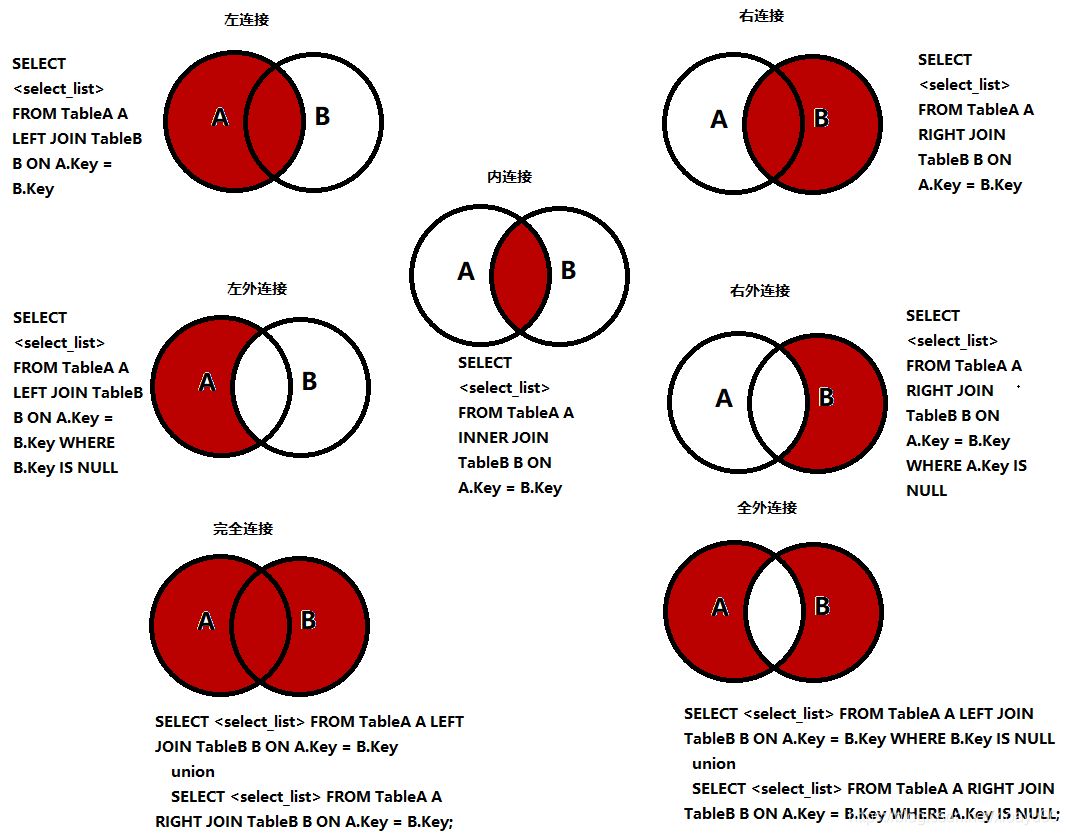4. DQL query data (most important)
4.1,DQL
Data Query Language
- All query operations use it to SELECT
- It can do simple query and complex query~
- The core language and the most important statement in the database
- Most frequently used statements
SELECT statement syntax
SELECT
[ALL | DISTINCT | DISTINCTROW ]
[HIGH_PRIORITY]
[STRAIGHT_JOIN]
[SQL_SMALL_RESULT] [SQL_BIG_RESULT] [SQL_BUFFER_RESULT]
[SQL_NO_CACHE] [SQL_CALC_FOUND_ROWS]
select_expr [, select_expr] ...
[into_option]
[FROM table_references
[PARTITION partition_list]]
[WHERE where_condition]
[GROUP BY {col_name | expr | position}, ... [WITH ROLLUP]]
[HAVING where_condition]
[WINDOW window_name AS (window_spec)
[, window_name AS (window_spec)] ...]
[ORDER BY {col_name | expr | position}
[ASC | DESC], ... [WITH ROLLUP]]
[LIMIT {[offset,] row_count | row_count OFFSET offset}]
[into_option]
[FOR {UPDATE | SHARE}
[OF tbl_name [, tbl_name] ...]
[NOWAIT | SKIP LOCKED]
| LOCK IN SHARE MODE]
[into_option]
Note: [] brackets represent optional and {} brackets represent mandatory

SELECT [ALL | DISTINCT]
{ * | table.* | [table.field1[ AS alias1][, table.field2[ AS alias2]][,...]]}
FROM table_name1[ AS table_alias]
[LEFT | RIGHT | INNER JOIN table_name2] -- Joint query
[WHERE ...] -- Specify the conditions to be met for the results
[GROUP BY ...] -- Specify which fields the results are grouped by
[HAVING ...] -- Secondary conditions that must be met to filter grouped records
[ORDER BY ...] -- Specifies that the query records are sorted by one or more criteria
[LIMIT {[ OFFSET,]ROW_COUNT | row_countOFFSET OFFSET}]; -- Specify which records to query from
4.2. Specify query fields
-- Query all students
-- SELECT field FROM surface
SELECT * FROM student
-- Query specified fields
SELECT `StudentNo`,`StudentName` FROM student
-- Alias, give the result a name AS((field or table)
SELECT `StudentNo` AS Student number,`StudentName` AS Student name FROM student AS S
-- function Concat (a,b)
SELECT CONCAT('full name:',StudentName) AS New name FROM student
Syntax: SELECT field FROM table
Sometimes, the names listed are not so well known by name, so we call them AS as
Table name / field name alias
De duplication distinc t
Function: remove the duplicate data in the result of SELECT query and display only one
-- Find out which students have taken the exam and their grades SELECT * FROM result -- Query all test scores SELECT `StudentNo` FROM result -- Check which students took the exam SELECT DISTINCT SELECT `StudentNo` FROM result -- Duplicate data found, de duplication
Database columns (expressions)
SELECT VERSION() -- Query System Version (function) SELECT 100 * 3 -1 AS Calculation results -- Used to evaluate (an expression) SELECT @@auto_increment_increment -- Query self increasing step size (variable) -- Student examination results + 1 Sub view SELECT `StudentNo`,`StudentResult` + 1 AS 'After raising points' FROM result
Expressions in the database: text values, columns, functions, calculation expressions, system variables.....
select `expression` from `surface`
4.3 where conditional clause
Function: retrieve qualified values in data
Search criteria: composed of one or more expressions! Result Boolean
Logical operator
Try to use English letters
| operator | grammar | describe |
|---|---|---|
| and && | a and b a && b | Logic and, double truth is true |
| or | ||
| not ! | not a ! a | Logical negation |
-- The query test score is 95~100 Between points SELECT StudentNo,StudentResult FROM result WHERE StudentResult >= 95 AND StudentResult <= 100 -- and && SELECT StudentNo,StudentResult FROM result WHERE StudentResult >= 95 && StudentResult <= 100 -- Fuzzy query (interval) SELECT StudentNo,StudentResult FROM result WHERE StudentResult BETWEEN 95 AND 100 -- Grades of students other than 1000 student numbers SELECT StudentNo,StudentResult FROM result WHERE StudentResult != 1000 -- != not SELECT StudentNo,StudentResult FROM result WHERE NOT StudentResult = 1000
Fuzzy queries: comparison operators
| operator | grammar | describe |
|---|---|---|
| IS NULL | a is null | If the operator is NULL, the result is true |
| IS NOT NULL | a is not null | If the operator is not NULL, the result is true |
| BETWEEN | a between b and c | If a is between b and d, the result is true |
| LIKE | a like b | SQL matches. If a matches b, the result is true |
| IN | a in (a1,a2,a3,...) | Suppose a is in it and the result is true |
-- ========= LIKE ======
-- Inquire about students surnamed Liu
-- like combination %(Represents 0 to any character) _(One character)
SELECT StudentNo,StudentName FROM student
WHERE StudentName LIKE 'Liu%'
-- Query the students surnamed Liu. There is only one word after their name(Two words__)
SELECT StudentNo,StudentName FROM student
WHERE StudentName LIKE 'Liu_'
-- Query the students with Jiazi in the middle of their names %Jia%
-- ========= IN(Specific one or more values) ======
-- Inquire about student 100110021003
SELECT StudentNo,StudentName FROM student
WHERE StudentName IN (1001,1002,1003)
-- Query students in Beijing `Address` IN ('Anhui')
-- ========= null not null ======
-- Query students whose address is empty null ''
SELECT StudentNo,StudentName FROM student
WHERE Address = '' OR Address IS NULL
-- Query students with date of birth is not null
SELECT StudentNo,StudentName FROM student
WHERE BornDate IS NOT NULL
4.4. Associated table query
JoinON

-- Query the students who took the exam (student number, name, subject number, score) SELECT * FROM student SELECT * FROM result /* thinking 1. Analyze the requirements and analyze which tables the query fields come from (connection query) 2. Determine which connection query to use? 7 kinds Determine the intersection (which data is the same in the two tables) Judgment condition: StudentNo in student table = StudentNo in grade table */ -- Inner join SELECT s.StudentNo,StudentName,SubjectNo,StudentResult FROM student AS s INNER JOIN result AS r WHERE s.StudentNo = r.StudentNo -- Right Join SELECT s.StudentNo,StudentName,SubjectNo,StudentResult FROM student s RIGHT JOIN result r ON s.StudentNo = r.StudentNo -- Left Join SELECT s.StudentNo,StudentName,SubjectNo,StudentResult FROM student s LEFT JOIN result r ON s.StudentNo = r.StudentNo -- join (Connected tables) on (Conditions of judgment) join query -- where Equivalent query -- Query the absent students SELECT s.StudentNo,StudentName,SubjectNo,StudentResult FROM student s LEFT JOIN result r ON s.StudentNo = r.StudentNo WHERE StudentResult IS NULL
| operation | describe |
|---|---|
| Inner join | If there is at least one match in the table, the row is returned |
| left join | All values will be returned from the left table, even if there is no match in the right table |
| right join | All values will be returned from the right, even if there is no match in the left table |
-- Thinking questions (query the information of students participating in the exam: student number, student name, subject name, score) /* thinking 1. Analyze the requirements, and analyze which tables student, result and subject the fields of the query come from (connection query) 2. Determine which connection query to use? Seven kinds Determine the intersection (which data is the same in the two tables) Judgment condition: StudentNo in student table = StudentNo in grade table */ SELECT s.StudentNo,StudentName,SubjectName,StudentResult FROM student s RIGHT JOIN result r ON r.StudentNo = s.StudentNo INNER JOIN `subject` sub ON r.subjectNo = sub.SubjectNo -- What data do I want to query select ... -- From which tables from `surface` XXX join `Connected tables` on Cross condition -- Suppose there is a multi table query. Take your time. First query two tables and then add them slowly
Self connection
Core: one table can be split into two identical tables
Parent class
| categoryid | categoryName |
|---|---|
| 2 | information technology |
| 3 | software development |
| 5 | Art design |
Subclass
| pid | categoryid | categoryName |
|---|---|---|
| 3 | 4 | database |
| 2 | 8 | Office information |
| 3 | 6 | web development |
| 5 | 7 | Art design |
Operation: query the subclass relationship corresponding to the parent class
| Parent class | Subclass |
|---|---|
| information technology | Office information |
| software development | database |
| software development | web development |
| Art design | ps Technology |
CREATE TABLE `category` (
`catetoryid` INT UNSIGNED NOT NULL AUTO_INCREMENT COMMENT 'theme id',
`pid` INT NOT NULL COMMENT 'father id',
`categoryName` VARCHAR(50) NOT NULL COMMENT 'Subject name',
PRIMARY KEY (`catetoryid`)
) ENGINE=INNODB AUTO_INCREMENT=9 DEFAULT CHARSET=utf8
INSERT INTO `category` (`catetoryid`,`pid`,`categoryName`)
VALUES
('2','1','information technology'),
('3','1','software development'),
('4','3','database'),
('5','1','Art design'),
('6','3','web development'),
('7','5','ps technology'),
('8','2','Office information');
-- Query parent-child information,Think of a table as like as two peas of two models.
SELECT a.`categoryName` AS 'Parent column',b.`categoryName` AS 'Sub column'
FROM `category` AS a,`category` AS b
WHERE a.`catetoryid` = b.`pid`
-- Query the grade (student number) and student name of the student,Grade name) SELECT studentNo,studentName,gradeName FROM student s INNER JOIN grade g ON s.gradeId = g.graId
4.5 paging and sorting
paging
-- Why pagination? -- Ease the pressure on the database, give people a better experience, waterfall flow -- Pagination, only five pieces of data are displayed on each page -- Syntax: limit `Starting value`,`Page size` -- Web application: current, total pages, page size -- LIMIT 0,5 1~5 SELECT s.StudentNo,StudentName,SubjectName,StudentResult FROM student s INNER JOIN result r ON s.StudentNo = r.StudentNo INNER JOIN `subject` sub ON r.SubjectNo = sub.SubjectNo WHERE subjectName = 'database structure -1' ORDER BY StudentResult DESC LIMIT 1,5 -- [pageSize: [page size] -- [(n-1)* pageSIze: Starting value] -- [n: [current page] -- [Total data / Page size = Total pages]
Syntax: limit starting value, page size
-- reflection: -- query Java Information of students whose scores in the first academic year are in the top ten and whose scores are greater than 80 (student number, name, course name, score) SELECT StudentNO,StudentName,SubjectName,StudentResult FROM student s INNER JOIN result r ON s.StudentNo =r.StudentNo INNER JOIN `subject` sub ON sub.SubjectNo = r.SubjectNo WHERE SubejectName = 'Java First academic year' AND StudentResult >= 80 ORDER BY StudentResult DESC LIMIT 0,10
sort
-- Sorting: ascending ASC Descending order DESC -- ORDER BY Which field is used to sort and how -- The query results are sorted in descending order according to their grades SELECT s.StudentNo,StudentName,SubjectName,StudentResult FROM student s INNER JOIN result r ON s.StudentNo = r.StudentNo INNER JOIN `subject` sub ON r.SubjectNo = sub.SubjectNo WHERE subjectName = 'database structure -1' ORDER BY StudentResult DESC
4.6 sub query
where (this value is calculated)
Essence: nest a subquery statement in the where statement
-- 1,Query database structure-1 All the test results (student number, subject number, score) are arranged in descending order -- Method 1: use connection query SELECT StudentNo,SubjectName,StudentResult FROM result r INNER JOIN `subject` sub ON r.SubjectNo = sub.SubjectNo WHERE SubjectName = 'database structure -1' ORDER BY StudentResult DESC -- Method 2: use sub query (from inside to outside) SELECT StudentNo,SubjectName,StudentResult FROM result r WHERE SubjectNo = ( SELECT SubjectNo FROM `subject` WHERE SubjectName = 'database structure -1' ) ORDER BY StudentResult DESC -- Query all database structures-1 Student ID SELECT SubjectNo FROM `subject` WHERE SubjectName = 'database structure -1'
4.7 grouping and filtering
-- Query the average score of different courses, the highest score, and the average score is greater than 80 -- Core: (grouped according to different courses) SELECT SubjectName,AVG(StudentResult) AS average,MAX(StudentResult) AS Highest score,MIN(StudentResult) AS Lowest score FROM result r INNER JOIN `subject` sub ON r.SubejectNo = sub.SubjectNo GROUP BY r.SubjectNo -- By what field HAVING average>80